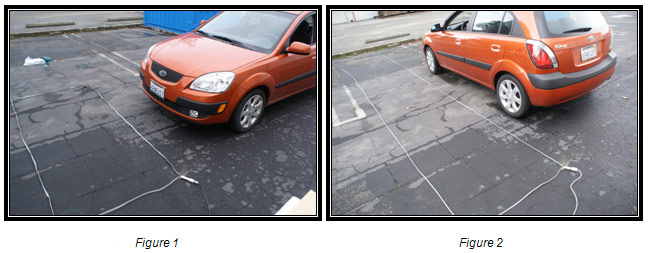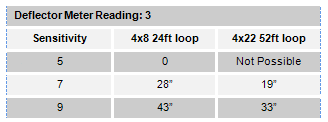Tests & Results
Stand Off Distance
Purpose:
Observe and record the distance required to obtain a detection with a loop. Eliminate any confusion and reinforce current recommendations about how far a loop should be installed (Stand off distance) from a gate.
Hypothesis:
If a loop is installed 4ft away, then a detection will not occur.
Materials:
– BD Loops preformed direct burial loop made of 14AWG wire.
– 1 RL 24-40 (4×8 (24ft) loop with a 40ft lead-in)
– 1 RL 52-40 (4×22 (52ft) loop with a 40ft lead-in)
– 1 EDI Detector Model#LMA-1250 Ser# 090600071 (detector has a deflector meter to show how much an object changes the inductance of a loop)
– 4 T-Pins (to hold loop in place)
– 1 Drill with masonry bit (to drill holes for T-Pins)
– Standard size vehicle 08’ Kia Rio5
Procedure:
Testing area was prepared by measuring and marking a 4×8 loop footprint. Holes were drill into the corners of the loop footprint and T-Pins were inserted. BD Loop’s 4×8 preformed loop was then wrapped around the T-Pins and connected to a detector. The detector was reset and set to a sensitivity level of 5.
The Kia then drove perpendicular to the loop’s 8ft leg (perpendicular to a gate, see figure 1) while the detector was monitored for a detection. Once a detection reading of 1 occurred the Kia stopped and a measurement was taken from the leg of the loop to the front tire of the vehicle. This measurement was then recorded. The Kia then backed up and the detector reset. Once again the vehicle approached the loop perpendicular to the loop’s 8ft leg while monitoring for a detection reading of 3. Once the detection occurred the measurement was taken and recorded. The above process repeated and data recorded for sensitivity levels 7 and 9, with a detection reading of 1 and 3.
The 4×8 loop was then replaced with a BD Loops 4×22 preformed loop, new holes were drilled and the loop secured in place. The above process was then repeated and data recorded for sensitivity levels 5, 7, and 9, with a detection reading of 1 and 3.
The Kia was then driven parallel to the loops 8ft leg (parallel to a gate, see figure 2) to simulate a gate. The above process was then repeated with a 4×8 and 4x22ft loop. The data recorded for sensitivity levels of 5, 7, and 9 with a detection reading of 1 and 3.

Results:
Perpendicular Test Data: *Distance is from loop leg to tire


Parallel Test Data: *Distance is from loop leg to tire

Results show as the loop size increases, the distance required to obtain detection decreases. The difference occurs because as the loop gets bigger, a larger more sizeable object (or more of the same object) is required to change the loop’s inductance.
Conclusion:
A loop installed 4ft away has the possibility of a detection occurring on the highest sensitivity setting.
BD Loops – What these Results Mean for Installers
A recommendation of keeping a distance 4ft away is still a good rule to follow. Although the test results of our parallel test (test to simulate gate travel) did show that detection can occur at 4ft (just barely) an installer would rarely set a detector to a sensitivity level of 9. To be cautious, a recommendation to increase the “Stand off” distance to 5ft if the loop diameter is greater than 40ft would be a good idea. A good understanding of loop phasing would also affect the “Stand off” distance of two loops hooked in series. Please call if you have any further questions.
BD Loops
The Loop Experts!
BD Loops was founded in 2001. Their preformed loops and accessories are designed with the installer in mind. BD Loops offers a complete loop system solution including preformed direct burial loops, preformed saw-cut loops, loop sealant, blades, testing devices, and installation tools. BD Loops has a reputation for reliability and ease of installation. They pride themselves on the quality of their products and their commitment to providing excellent customer service and support. BD Loops preformed loops are made in the USA at their facility in Placentia, CA.

